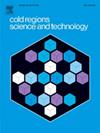Safety assessment of the Qinghai–Tibet railway: Monitoring, analysis, and prediction
IF 3.8
2区 工程技术
Q1 ENGINEERING, CIVIL
引用次数: 0
Abstract
The temporal and spatial evolution regularity of the surface along the Qinghai–Tibet railway (QTR) have been examined, and intelligently sensing the potential risks is of considerable importance to its safe operation. 1166 Sentinel-1 A images from Jan. 2017 to Apr. 2023 were collected to obtain·1956 km of surface deformation along the QTR using the Small Baseline Subset Interferometric Synthetic Aperture Radar (SBAS-InSAR) technique. Satellite + UAV multi-scale 3D modeling was used with Beijing 3 (BJ-3) satellite images and key tunnel entrance drone images. Risk assessment of key geologic hazards and 3D reality verification was performed along the QTR. The QTR surface deformation was unevenly scattered in space and the maximum annual deformation rates recorded were 26 mm/year. In the permafrost region, railway deformation settled at a constant rate in the warm season and rose slowly in the cold season. Under climate warming, the warm season gradually became longer than the cold season. Adding precipitation and temperature to the analysis showed that the deformation in permafrost regions had significant aggregation characteristics. A large deformation along the railway occurred, and human activities were frequent. The reliability of the InSAR technique was verified by using Global Navigation Satellite System (GNSS) reference data along QTR. InSAR results correlated strongly with GNSS data. The Tent Mapping Sparrow Search Algorithm Long Short-Term Memory (Tent-SSA-LSTM) was proposed to forecast the forthcoming deformation along the QTR to achieve early detection and early warning. Compared with the traditional prediction model, evaluation increased by 34.1 %, 40.1 %, and 36.3 %, respectively. The findings can provide a scientific foundation for pertinent government departments in rescue and disaster prevention.
求助全文
约1分钟内获得全文
求助全文
来源期刊

Cold Regions Science and Technology
工程技术-地球科学综合
CiteScore
7.40
自引率
12.20%
发文量
209
审稿时长
4.9 months
期刊介绍:
Cold Regions Science and Technology is an international journal dealing with the science and technical problems of cold environments in both the polar regions and more temperate locations. It includes fundamental aspects of cryospheric sciences which have applications for cold regions problems as well as engineering topics which relate to the cryosphere.
Emphasis is given to applied science with broad coverage of the physical and mechanical aspects of ice (including glaciers and sea ice), snow and snow avalanches, ice-water systems, ice-bonded soils and permafrost.
Relevant aspects of Earth science, materials science, offshore and river ice engineering are also of primary interest. These include icing of ships and structures as well as trafficability in cold environments. Technological advances for cold regions in research, development, and engineering practice are relevant to the journal. Theoretical papers must include a detailed discussion of the potential application of the theory to address cold regions problems. The journal serves a wide range of specialists, providing a medium for interdisciplinary communication and a convenient source of reference.
 求助内容:
求助内容: 应助结果提醒方式:
应助结果提醒方式:


